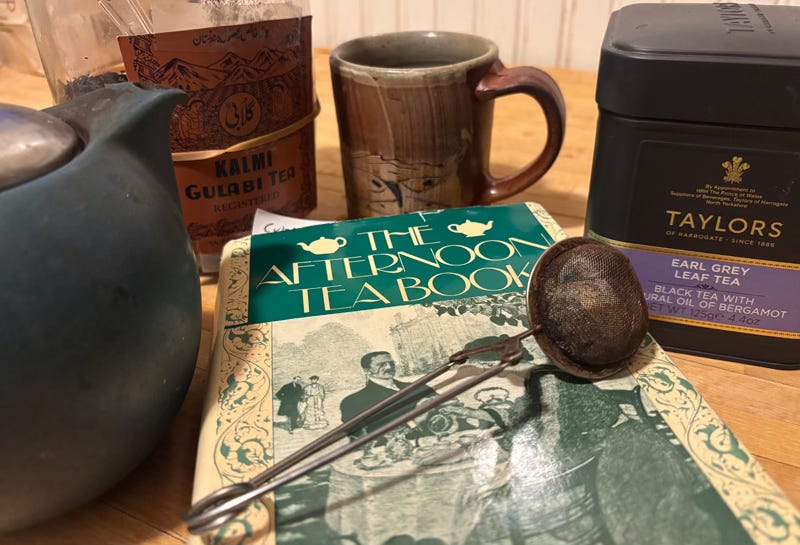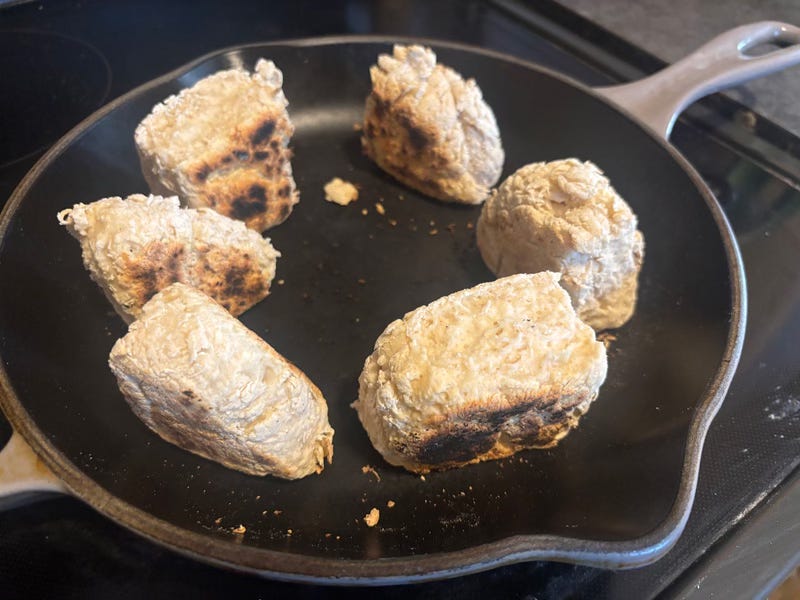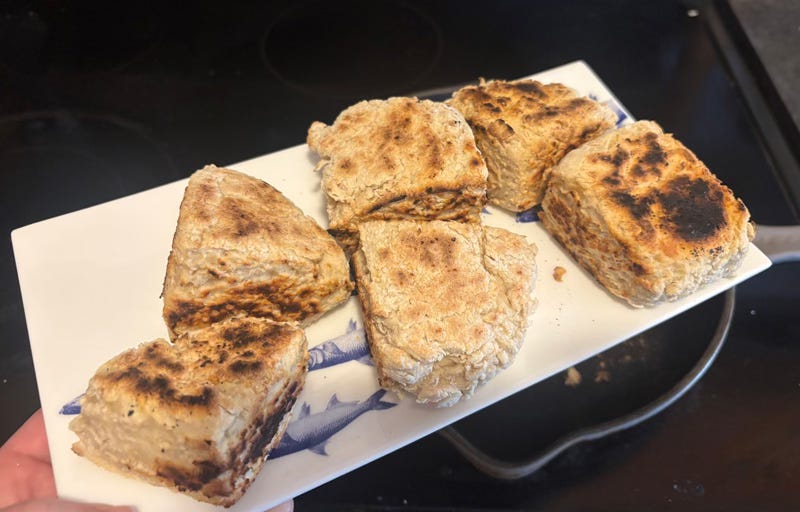THE COOKBOOK TEST #0075: THE AFTERNOON TEA BOOK
INSTALLMENT #0075 (FREE) AN ANCIENT HABIT / DOWN THE RABBIT HOLE / SCONEHENGE / A SANDWICH FIT FOR A SPECIFIC QUEEN / A LEMON LOAF FROM THE MY LITTLE PONY COOKBOOK
Dear Readers,
As an American, I’m not really supposed to understand or even care about tea. We are, on balance, a coffee people, and mostly a bad coffee people: milkshakes disguised as coffee from Starbucks, or brown dishwater disguised as coffee at diners, workplaces, and even at various restaurants that should certainly know better.
However: I grew up with parents who drank tea every evening, without fail. I even grew up making that tea (invariably with milk and sugar) and toting it out to the living room where they were playing backgammon and watching Spenser for Hire (see above) or L.A. Law or Moonlighting.
Now, as a man slipping out of my late 40s into nearly certain death in the increasingly non-distant future, I also find myself drinking tea nearly every evening, often also while watching Spenser for Hire or Moonlighting. [1]
This isn’t to say that I’m a tea expert, or even a respectable tea enthusiast. I buy loose tea in Indian, Russian, or Turkish markets because it seems to be both much better and/or considerably cheaper than what they’re selling in the supermarkets, but that’s about where my knowledge ends.
Right now I’m going through a really big container of Kalmi Gulabi Tea that I picked up at the Caspian Marketplace. I think this may be my thing for a while, but I still have a weakness for the Indian market Lipton brand stuff, which comes loose leaf and has a bunch of Arabic writing on the box. It makes American Lipton tea look and taste like the absolute vacuum cleaner lint that it is.
And as little as I know about tea (quite little), I know even less about the British tradition of tea-as-a-meal. Before going into tea-making methods and a brace of classic tea-related sweet and savory recipes, THE AFTERNOON TEA BOOK breaks down no fewer than seven different kinds of teas, including high teas, family teas, at home teas, wedding teas, nursery teas, bridge teas, and tennis teas. Is that exhaustive? I don’t think so! Is there considerable overlap between many of these various teas? Maybe? It would really help here if I were English!!
The challenge and joy of The Afternoon Tea Book is that the author was so English that I’m guessing most English people felt sort of American in his presence. Food historian Michael Smith, to go by the book jacket notes, was dubbed “the doyen of English cookery” by the New York Times, served as a consultant on Upstairs, Downstairs, and set the bar for English cookery on BBC, among other titanic English food-focused achievements. In short: the author isn’t playing around here, and I, for one, am grateful for his fussily overprepared approach.
at your service,
James
THE AFTERNOON TEA BOOK
MICHAEL SMITH
ATHENIUM | 1986
This book is a testament to how much you can pack into a seemingly ordinary-sized volume if you have the will to do so. It opens with a magisterial 81-page history of tea: its historical origins, its various varieties, its emergence as a cultural and commercial powerhouse of English culture, its many social uses and folkways, and a lot of terrific trivia. Did you know, for example, that “tea blenders” … well, I’ll let the author tackle this bit.
For wealthy gentlemen, evening tea would be specially prepared and served in the tea gardens or the tea rooms and clubs, by attractive young wenches known as tea blenders, who often “got to know” their employer and his friends in more than one sense!
Oh, Mr. Smith, please DO behave!! I quote the passage above because I love a classic bit of “we don’t really say that anymore”-style cringe, but it doesn’t do justice to Smith’s actual overall tone. That, thankfully, is confidently professorial and neatly turned, like this passage here:
The bulk of tea drunk in Britain today is blended. In the eighteenth century, the hostess would blend her own balance of green and black teas, taking them from her caddy and measuring them with her silver caddy spoon into a crystal mixing bowl. Realizing the value of a good sales point, the local grocery often adopted the blend of the lady of the manor for others to enjoy. The merchants also created their own blends, which at first were regional if not local, but today are national or even international. It is doubtful that a packet of Earl Grey purchased from your nearest supermarket would bear any resemblance to His Lordship’s original mix, but the romantic idea that it does is still an excellent sales point, for we all hanker after a taste of the past.
Smith writes crisply and clearly while delivering enormous packets of historical and contemporary facts, figures, dates, and names - this is popular history, readable and accessible, but well constructed and reinforced with thoughtful quotations and citations throughout.
And then come the recipes: a deluge of brief, elegant, focused methods for breads, scones, cakes, sandwiches, cookies, compound butters, and jam sufficient to supply a sprawling menu for an ambitious chain of teahouses.
Let’s give a few of them a try.
A SANDWICH FIT FOR A SPECIFIC QUEEN
There are so many interesting sandwiches in The Afternoon Tea Book (smoked haddock! toasted oatmeal! caviar!) that choosing one to test was a tough decision. I ended up picking Queen Adelaide’s Sandwiches because they involved an intriguing compound butter, and because their linkage to a specific historical figure meant that I could blame a member of the royal family if anything went wrong.
Naturally, minor digging revealed that Queen Adelaide was maybe one of the least reprehensible members of any royal family ever, and would therefore make a lousy fall-monarch for a mediocre sandwich:
She refused to have women of questionable virtue attend her Court; the Clerk of the Privy Council, Charles Greville, wrote, "The Queen is a prude and refuses to have the ladies come décolletées to her parties. George the 4th, who liked ample expanses of that kind, would not let them be covered." In any case, Adelaide was beloved by the British people for her piety, modesty, charity, and her tragic childbirth history.
Back to sandwiches: the Queen Adelaide consists of bread, tomato curry and orange butter, and a mix of ground ham and chicken bound with heavy cream and laced with minced scallions. I used finely chopped canned chicken from Costco and finely chopped SPAM; no regrets.
My first attempt at these sandwiches went too hard on the compound butter, which was rich and packed a big spice-driven kick that actually overpowered the relatively mild and mellow creamy chopped meats. Nevertheless, not bad - a lot of interest from the curry and orange flavors, and the meat was substantial without feeling heavy.
A second attempt was better: I toasted the bread and went lighter on the compound butter, yielding an almost refreshingly light and tasty sandwich that packed enough caloric wallop to make for a satisfying lunch. In fact, the impact and appearance of these things really reminded me of Denmark’s famous open-faced sandwiches, many of which also carry meat salad-based payloads and play with intriguing flavor twists.
Overall: tasty and worth revisiting, and an invitation to explore some of the book's many other sandwich recipes next time an occasion calls for something light and snacky.
QUEEN ADELAIDE’S SANDWICHES
20-24 slices brown or white bread
Tomato Curry and Orange Butter (see below)
1 cup canned chicken breast, finely chopped
1 cup SPAM, finely chopped
2 scallions, finely minced
Up to ½ cup heavy cream to bind
Salt and pepper to season
Combine ham, chicken, and scallions in a bowl. Add enough heavy cream to form a spreadable paste, and season with salt and pepper. Lightly butter 10-12 slices of bread with the Curry and Orange Butter and spread with a layer of the chicken and ham filling, top with a second slice of bread, crust and cut as desired.
CURRY AND ORANGE BUTTER
Combine in food processor:
1 stick butter, softened
¼ tsp salt
1 Tbsp tomato paste
1/2 tsp orange zest
1 ½ tsp Madras curry powder
Keep extra butter in the refrigerator; soften before serving again.
SCONEHENGE
When I hear the word “girdle” I immediately think “William Shatner.” It’s pure reflex. But The Afternoon Tea Book recipe for Girdle Scones is mercifully free of undergarments and instead seems to revolve around what we Americans would call a “griddle.” Similar word, different meaning, but welcome to exactly the sort of delightful contretemps that define the trans-Atlantic friendship that binds our wonderful democracies together.
I have been making excellent buttermilk biscuits since before the birth of my children, so I am resentful of any recipe that approaches that one without also being exactly the same recipe. This was therefore an emotionally difficult mission for me to complete.
It also needed a bit of tinkering: the originally called-for ½ cup of buttermilk didn’t bind the dough properly, so I goosed it up to nearly a cup, and the called-for five minutes each on their tops and bottoms in the pan didn’t finish the baking, so I also let them cook for about four minutes on their sides (thereby creating Sconehenge) to make sure they heated through and cooked completely.
The result: A breakfast treat that was minimalist compared to the symphony orchestra of butter that is my usual buttermilk biscuit, but a treat nonetheless. Jazzed up with some jam and/or honey and/or butter these were quite tasty, and their minimalist approach would be most welcome with some clotted cream at an afternoon tea.
My son gave them a solid thumbs up and ate two of them, which is encouraging, but he’s already starting to eat like a linebacker, so it’s possible his standards will be getting less discerning in the teenage years to come. But then again, I’m as jaded as they come and I enjoyed these too, so they get a passing grade.
GIRDLE SCONES
2 cups all-purpose flour
½ tsp baking soda
1 tsp cream of tartar
¼ tsp salt
1 tsp sugar
¾-1 cup buttermilk
Heat a greased cast iron pan or griddle on medium.
Whisk together dry ingredients, add the buttermilk, and mix to an elastic dough; add a bit more milk if dry scraps of dough refuse to bind with the mass. Turn onto a floured work surface and knead lightly until smooth, then roll out ½ inch thick and cut into 6-8 squares.
Cook scones on griddle until risen and starting to brown, about 6-8 minutes per side, turning halfway through.
A BRIEF JOURNEY INTO THE MY LITTLE PONY-VERSE
Look: I just don’t have it in me to do a post about the MY LITTLE PONY BAKING BOOK. It’s written for six-year-olds and almost everything in it has sprinkles and/or chopped up candy bars on it. It’s not great! But my daughter really enjoys it!
I was able to steer her away from some of the more rainbow and/or sprinkle-based atrocities into a fairly sedate-looking lemon loaf recipe which, by the way, would be just perfect if sliced up and served with tea.
Although the recipe needed a bit of organizational tweaking and abridging, it actually came out beautifully and I think we’ll be making it again - it was sweet enough to delight without being saccharine, and the hit of lemon was intense enough to elevate it into the realm of “balanced and craveable.”
ICED LEMON LOAF
1 ½ cups all purpose flour
¼ tsp salt
¼ tsp baking soda
¼ tsp baking powder
½ cup butter, room temperature
1 cup granulated sugar
3 large eggs
2 Tbsp lemon zest (from 1 large lemon)
1 Tbsp lemon juice
2 tsp vanilla
⅓ cup sour cream
Icing
½ cup powdered sugar
1 Tbsp lemon juice
Preheat oven to 325 F and grease a loaf pan. Whisk together flour, salt, baking soda, and baking powder in a small bowl. In a mixer bowl, blend butter and sugar until fluffy, about 3 minutes. Add eggs one at a time, then lemon juice, lemon zest, and vanilla. Add the flour mixture and the sour cream and mix until blended. Bake for 50-60 minutes, until a toothpick inserted into the center comes out clean. Cool for 15 minutes, then remove cake from pan to cooling rack. Cool completely (about an hour), then mix the powdered sugar and lemon juice and brush it on as an icing.
THE AFTERNOON TEA BOOK
(***BUY IT / BORROW IT*** / SKIP IT / SCRAP IT)
Due to its depth, its sense of focus, its deeply steeped (sorry) sense of history, and its delightfully authoritative and superbly fussy voice, this book is a must-have for any serious lover of tea (in the beverage sense) or tea (in the British snacks / light meal / heavy meal plus beverage sense.) If tea isn’t your jam (sorry), there’s still much to like about this book, including a number of snacky sandwich and appetizer recipes that work in just about any context. The book practically boils over (sorry) with practical hosting concepts. Something about a kettle? Could that work? Seems like a stretch.
FOOTNOTES
[1] I don’t find it likely that L.A. Law aged as well as Spenser for Hire or Moonlighting, and I do remember it going downhill pretty hard after what’s-her-face fell down the elevator shaft. Rosalyn? I think it was Rosalyn.
Anyway, here’s another still from Spenser for Hire. This one is an action shot of Spenser and Hawk running together across a rooftop down near the harbor.












Oh wow, that makes me want to get out my Spenser DVDs. They filmed an episode in my hometown!